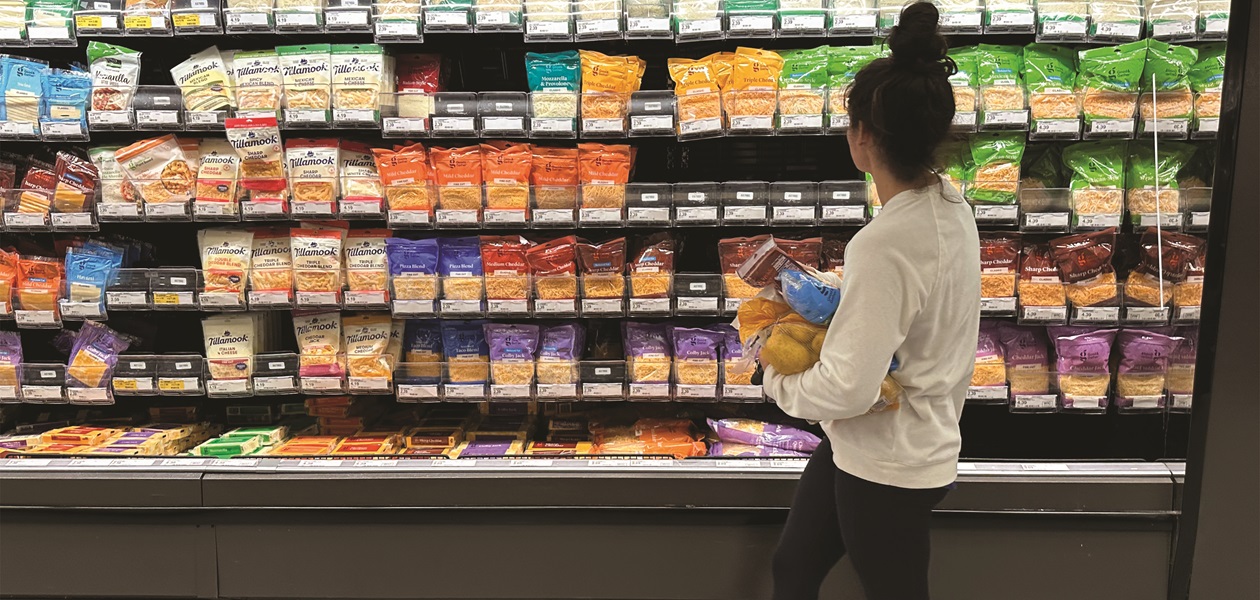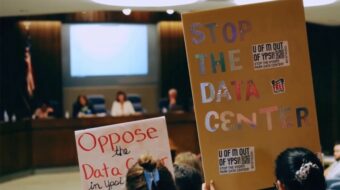
The spooky season may be over, but as we head towards the winter holidays, a real terror is plaguing working-class people. They’re being told that the economy is getting better and that inflation is slowing down, but their dwindling bank accounts tell them a different story whenever they go to buy everyday necessities.
That’s because, despite tweets and corporate news headlines to the contrary, the economy is not doing well for working-class people. Prices might be rising a bit slower, but they’re certainly not going down. Working people feeling the brunt of the rising cost of living isn’t something out of the ordinary; it’s a recurring symptom of a deeper systemic problem.
Inflation hit a 40-year record high in June 2022, with consumer prices increasing 9.1% over the course of 12 months. This is measured by looking at the rising cost of a select group of 80,000 foods and services in the United States throughout the year. What the Consumer Price Index (CPI) tracked was something most of us already knew: We’re paying more and getting less.
The latest CPI report revealed that the cost of U.S. goods and services stayed flat in September compared to the month before, with a year-over-year rate of 3.7%. While this rise in prices is down from the 9.1% of last year, it still means they’re going up. And when it comes to the cost of notable goods and services—such as housing, gas, and groceries—prices have remained well above pre-pandemic rates.
It is no wonder that in recent polls—such as the Suffolk University Sawyer Business School/USA TODAY survey—70% of Americans believe the economy is getting worse, not better.
One could argue that this is because graphs and economic data jargon are no match for what many working people see right in front of them when they go to the grocery store, fill up their car, or pay their rent. Many corporations made record-high profits in recent years, but people who work for a living have seen few gains aside from the ones that they fought for and won on picket lines.
The feeling that things don’t add up—the kind of feeling working people get when they’re told by the news that the good times are here again—isn’t imaginary. It’s a sign that something is wrong, and it’s built into the capitalist system.
How does it work?
What exactly does inflation mean? Inflation isn’t just the rate at which a select number of goods and services increases in price. It is the decline of purchasing power over time. For example, perhaps at one time, you were able to buy 20 items at the store for $50. Now, your $50 only gets you 12 of those same items.

If we are to go by mainstream economics, we are told that there are two types of inflation:
Demand-pull inflation is driven by an increase in total consumer demand. This is when people are buying more products than businesses can supply. When the demand is higher than the supply, businesses raise prices. This is under the guise that the higher demand makes their goods more valuable, so they charge more. As an example, the public wants to buy more cars than manufacturers can produce, so the price will rise as customers chase the few automobiles available.
Cost-push inflation occurs when the cost of production rises. These increased production costs may lead to a decrease in total supply thus push businesses to increase prices in order to compensate. If the price of steel goes up, then those same car manufacturers pass along those costs to their customers.
Then there are factors that are beyond the direct relationship of supply and demand that can affect the economy. This can include natural disasters, wars, and other major world events that can disrupt supply chains and reduce the amount of goods available.
These factors can occur separately or all at once. Now, of course, this all seems pretty cut and dry, but the way in which the government and those in power have always chosen to “fix” inflation usually has it so working people—and their hard-earned money—end up as collateral damage.
That’s because the way that inflation, and the way the economy in general, is explained often takes corporate greed and exploitation out of the equation—making it seem like inflation is a natural occurrence that no one can foresee or control. That is not the case, as the way in which corporations and banks are allowed to function lays the groundwork for the constant cycle of financial upheaval.
When the news of inflation hitting a record high first made the rounds in 2022, there were many economic pundits and public officials using coded language to discuss their strategy for fixing the problem—which often resulted in placing the blame on workers for demanding higher wages.
That’s right, instead of questioning why businesses, that had seen record profits, were still raising prices higher, there was instead rhetoric that suggested that working people being able to afford things was where the real issue lay.
As reported in People’s World in July, an economist with one of the world’s top banks, Kokou Agbo-Bloua, had no shame in calling for governments to deal with inflation by cutting jobs and slashing wages. The banker is quoted as saying, “The central banks need to trigger a recession to force unemployment to pick up and create enough demand destruction, but we’re not there yet.”
As mentioned before, one of the reasons given for inflation is demand-pull, a.k.a. consumers having more money and thus being able to spend more. Well, it can then be interpreted that “demand destruction” would mean making it so workers have less money to spend. How does one do that? Through unemployment, lower wages, and high interest rates.
When it comes to higher interest rates, this is where the central banking system of the United States—the Federal Reserve—comes into play.
As in the past, when inflation has occurred, the Federal Reserve has raised interest rates in order to slow down the economy. The logic behind this is that if interest rates are higher this will make it so banks charge more for loans. Thus, it becomes more expensive for businesses and regular people to borrow money. This will then make it so that, in an effort to pay back loans or save, businesses will then be justified in laying off employees. And then we get the result that banker was pushing for higher unemployment and less money in the pockets of workers. This would result in less—you guessed it—demand.
And in the case of the individual borrower, higher interest rates mean more of their money is spent paying down their loan than purchasing new goods and services. This would also result in individuals not buying homes or spending as much when it comes to their credit cards.
This is what happened during what was called the “Volcker Shock” of 1979. Democratic President Jimmy Carter appointed Paul Volcker as chair of the Federal Reserve at this time as inflation was running high. This high could be attributed to a number of factors, such as the oil crisis of 1973 and wasteful military spending during the Vietnam War. Yet Volcker’s answer to dealing with inflation was to zero in on the gains made by workers through unionization.
Volcker is quoted as saying during congressional testimony in 1979, “The standard of living of the average American has to decline. I don’t think you can escape that.”
And so he set about achieving that goal, opening up of the floodgates for a number of setbacks for working people that reverberated throughout the following decades—such as the real wages of U.S. workers staying stagnant for nearly 40 years.
History repeating
The current Federal Reserve under Jerome Powell has been attempting to slow inflation through a number of interest rate hikes since March of last year. The central bank’s rate is now in a percentage range of 5.25 to 5.5. These are the highest interest rates seen in over 20 years.
And while the Biden administration has touted that inflation is down by 65% and the unemployment rate is still under 4%, working people continue to feel the pinch due to this inflation and the government’s strategy of “taming” it.
According to the U.S. Department of Education, federal student loan interest rates for undergrads have risen from 4.99% to 5.5% for the 2023-24 school year. Meanwhile, Bankrate.com reports that at present the average credit card charges a record-high 20.60% interest rate. That is an increase from 16.34% before the Federal Reserve started raising rates in 2022. The report notes that “not only has it become more expensive to borrow money using a credit card, it has become more difficult to qualify for a credit card as well.” And we haven’t even mentioned the cost of shelter (home ownership and rent costs), which remains high.
As reported by CNBC on Nov. 9, Powell remarked in a speech at the International Monetary Fund research conference in Washington: “My colleagues and I are gratified by this progress but expect that the process of getting inflation sustainably down to [the goal of] 2 percent has a long way to go. We will keep at this until we succeed.”
What does “keeping at it” entail, exactly? Well, if we are to go by the current financial policies plaguing the wallets of working people, it would mean continued high interest rates that ultimately affect workers more than bosses and big business. Powell confirmed as much when he later added in his speech that the Fed is focused on “whether rates need to go higher and how long they need to stay elevated.”
No wonder working people are feeling like the economy isn’t getting better. It’s because “better” is subjective in this case, depending on which class of people you’re dealing with. Especially when we consider that the strategy of “fixing” inflation doesn’t get at the root cause of the problem in the first place—riches and the power to raise prices being concentrated in the hands of the wealthy few.
The real culprit
As professor and former U.S. Secretary of Labor Robert Reich noted after the most recent Republican presidential debate: “Republicans want to blame inflation on Biden. Do you know what they never want to talk about? The deeper structural driver of inflation: The concentration of the American economy in the hands of a few corporate giants with the power to raise prices.”
This is ultimately the elephant in the room that many government officials and politicians rarely like to acknowledge. The recent gains in wages and unionization by workers are not the culprit of inflation. In fact, despite these gains, many workers are still under the federal minimum hourly wage of $7.25. That’s not enough to keep up with the rising cost of shelter and bills let alone be responsible for driving up demand and prices.
No, in a time when the profits of the 500 largest companies listed on the stock exchange rose by 50% in 2021, it is clear to see that while workers are footing the bill, they’re not the ones eating from the biggest plate.
In a so-called “free-market economy,” the supposed truest form of capitalism, businesses are allowed to do whatever they want in order to obtain the biggest profits. That means government shouldn’t legislate or interfere—until the banks and businesses need bailing out, of course—and that big corporations should be free to earn wealth as they see fit. It’s the idea that if big business makes money, this money will trickle down to the rest of us.
What does this have to do with inflation, you ask? Well, history has shown us that big business and the 1% do not like to share. In fact, they hoard their money and will sit on it—instead of investing back in production and the economy—if they think it won’t allow them to gain the most amount of profit.

This greed is the reason why companies have kept their prices high. As journalist Dion Rabouin of The Wall Street Journal explained after listening to hours of company earning calls with investors: “Companies aren’t being forced to raise prices because of inflation. They’re raising [prices] because they can.” Rabouin asserts that companies are raising their prices at a pace that far outruns what’s needed to compensate for rising production costs.
This isn’t a conspiracy theory, but rather a steal happening in plain sight. Simply looking at these companies’ net margins (the gap between cost and profit) shows that during this period of high inflation, corporations are making record gains. Unlike the rest of us, they’re not struggling to keep up.
And these companies are allowed to exploit this price gouging because government policies that favor big corporations have allowed them to run rampant. Corporate monopolies have made it so that when companies raise their prices, consumers are often left with little choice in alternatives.
Not to mention the fact that at the base of it all, as explained by Karl Marx, the first way in which corporate bosses make their wealth—before they’re even able to over-charge for a good or service—comes from them underpaying the workers who create their goods in the first place.
When workers fight for higher wages and better working conditions, as we’ve seen in the massive union struggles this past year, companies complain this is cutting into their revenue. They use this as an excuse for raising prices, when in reality they’ve been underpaying their workers from the onset, and a percentage uptick is not significantly detrimental to their bottom line.
But they want us all to think it is.
They do this so they can justify their short-sighted drive for instant profit at the expense of the long-term security of working people—whom they need in order to continue making their profit. It’s a system riddled with contradictions that ultimately has working people suffering the most.
So yes, prices are going up a little slower than they were last year, but they’re still going up and inflation alone is not the problem we face anyway. Working people are rightfully mad because the victories some of us have won when it comes to better pay are being gobbled up by corporate greed. Workers didn’t create the mess, but we seem to be the ones charged (pun intended) with cleaning it up.
With the 2024 presidential election drawing closer, it is imperative that progressive forces don’t dismiss this dissatisfaction with jargon and disassociated percentages. Rather, there needs to be a thorough discussion of the real problems—the cause—and what will be done to deal with them.
We hope you appreciated this article. At People’s World, we believe news and information should be free and accessible to all, but we need your help. Our journalism is free of corporate influence and paywalls because we are totally reader-supported. Only you, our readers and supporters, make this possible. If you enjoy reading People’s World and the stories we bring you, please support our work by donating or becoming a monthly sustainer today. Thank you!










